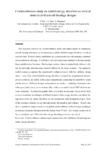Mostrar o rexistro simple do ítem
Crashworthiness study on hybrid energy absorbers as vertical struts in civil aircraft fuselage designs
| dc.contributor.author | Paz Méndez, Javier | |
| dc.contributor.author | Díaz, J. | |
| dc.contributor.author | Romera, Luis | |
| dc.contributor.author | Teixeira-Dias, F. | |
| dc.date.accessioned | 2020-02-14T17:06:28Z | |
| dc.date.issued | 2019 | |
| dc.identifier.citation | Javier Paz Mendez, Jacobo Díaz Garcia, Luis E. Romera Rodriguez & Filipe Teixeira-Dias (2019): Crashworthiness study on hybrid energy absorbers as vertical struts in civil aircraft fuselage designs, International Journal of Crashworthiness, DOI: 10.1080/13588265.2019.1605723 | es_ES |
| dc.identifier.uri | http://hdl.handle.net/2183/24911 | |
| dc.description.abstract | [Abstract:] This research concerns the crashworthiness study and enhancement of commercial aircraft fuselage structures by incorporating crushable hybrid energy absorbers to work as vertical struts. To assess their contribution on a representative aircraft structure, a numerical simulation of a Boeing 737-200 drop test is developed and validated with experimental data available in the literature. The fuselage section is then simulated both with and without the fuel tank, showing more harmful effects for the latter scenario. The numerical model accurately captures the experiment’s collapse process with low artificial energy ratios. Later, four vertical hybrid energy absorbers designed for programmed and progressive collapse, are added in the cargo compartment, connecting the underfloor beams and the frames. Different designs and positions are studied, combining aluminum tubes with square and circular cross-sections, filled with a core made from a GFRP skeleton and foam extrusions. Acceleration graphs show a reduction in passenger injury levels from severe to moderate according to an Eiband diagram when energy absorbers are fitted. Energy trends from the hybrid absorbers are also monitored, with dissipation of up to 10 kJ of the fuselage’s kinetic energy through plastic deformation and collapse. Results also show a significant improvement on the global crashworthiness of the fuselage, leading to an increase in plastic dissipation by the frames from 76 kJ to 122 kJ and a reduction on the accelerations up to 50% when the energy-absorbing structures are added. | es_ES |
| dc.description.sponsorship | Ministerio de Economía, Industria, y Competitividad. MINECO; DPI2016-76934-R | es_ES |
| dc.description.sponsorship | Ministerio de Economía, Industria, y Competitividad; DPI2016-76934-R | |
| dc.language.iso | eng | es_ES |
| dc.publisher | Taylor & Francis Online | es_ES |
| dc.relation.uri | https://doi.org/10.1080/13588265.2019.1605723 | es_ES |
| dc.subject | Crashworthiness enhancement | es_ES |
| dc.subject | Numerical model validation | es_ES |
| dc.subject | Eiband diagram | es_ES |
| dc.subject | Hybrid energy absorbers | es_ES |
| dc.title | Crashworthiness study on hybrid energy absorbers as vertical struts in civil aircraft fuselage designs | es_ES |
| dc.type | info:eu-repo/semantics/article | es_ES |
| dc.rights.access | info:eu-repo/semantics/embargoedAccess | es_ES |
| dc.date.embargoEndDate | 2020-10-31 | es_ES |
| dc.date.embargoLift | 2020-10-31 | |
| UDC.journalTitle | International Journal of Crashworthiness | es_ES |
| dc.identifier.doi | 10.1080/13588265.2019.1605723 |
Ficheiros no ítem
Este ítem aparece na(s) seguinte(s) colección(s)
-
CITEEC-ME - Artigos [31]






